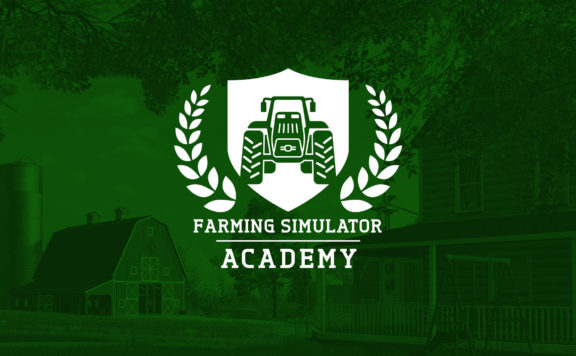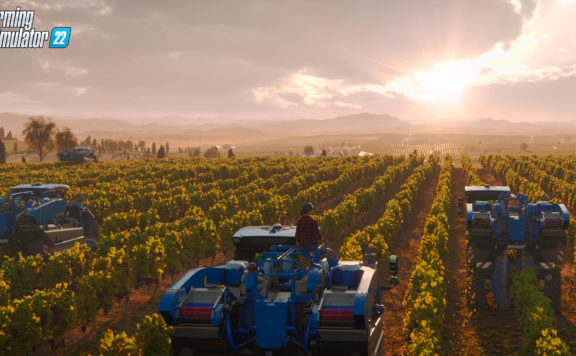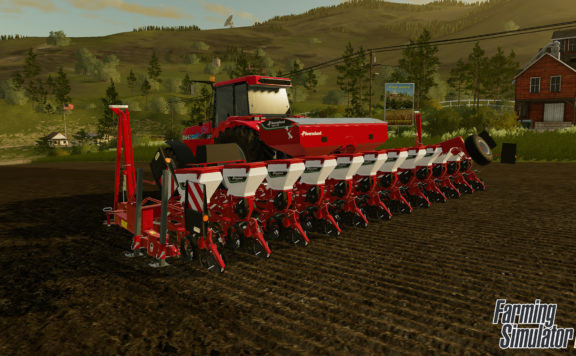The Farming Simulator [FS] video game was introduced to the gaming world on the 14th of April 2008 by GIANTS Software, headquartered in Zürich. Thirteen years later, the simulation game has several versions and is waxing strong in popularity. It is presently one of the top farm games in the world and has generated millions of dollars since its inception.
History of the Farming Simulator Series

The success of the first version led to a quick expansion of GIANTS Software and laid the foundation for subsequent versions. GIANTS has tried to continuously introduce new ideas and features to each new version of FS. For instance, the 2011 version ushered in cattle breeding which created a cost – regularly feeding the cattle and brought some benefits – milk and natural fertilizer. The 2012 Simulator was the first to be released on mobile [others include versions 14, 16, 18, and 20]. It featured three crops – corn, wheat, and canola. In FS 2013 [which also had a “Titanium Edition”], sheep and chickens joined cows on the farm. There was also a new US farming environment captured in a ‘Westbridge Hills’ map, among many other innovations.
More animals were added in the 2014 version which was released in November 2013. Other notable additions include better graphics, a large new map, and capacity for building construction as well as buying farmland. The developer also boosted the game’s graphics leading to better textures and enhanced objects details. It also introduced a brand new large map along with the possibility of constructing buildings and purchasing plots of land. In 2015, the Scandinavian landscape was added as one of the two farming locations. The new landscape had more forests than previously. Hence, new tree-cutting machines were invented to ensure efficient forest management. A car wash was also another of the number of new features in this episode. It was further updated to “Gold” and “Silver” editions for consoles, both of which were launched on October 29, 2015.
FS 16 brought new 3D graphic enhancements and introduced five new crops – corn, sugar beet, canola, potatoes, and wheat. More crops – oilseed radishes, soybeans, and sunflowers followed suit in the base game of version 2017. These new base game plants were previously available only through mods. Freight trains were also introduced in FS 17 meaning that a large number of goods could be moved around.
Innovation for the 2018 installment includes brand new machines, new front loader attachments that expand your transportation options, and new 3D graphics that provide greater detail on your machinery and the southern US environment. The 2019 version was released in November 2018 and ten days later, a million copies had been purchased. This success partly accounted for the 2019 record revenues posted by the game’s publisher, Focus Home Interactive. The remarkable patronage of the popular FS 19 has been attributed to some of the game’s new features such as landscaping, a feature that fans have previously been yearning for.
FS 2020 unveiled a new North American environment and allowed players to ride their horses. Among the other new features are the inclusion of equipment by John Deere, [the world’s largest manufacturer of agric machinery], a new map, two new crops – cotton and oats, etc.
Farming Simulator 21 Makes Way for Farming Simulator 22
On June 22, 2021, GIANTS announced that the newest installment of its popular series – Farming Simulator 22, will be released on November 22, creating palpable excitement among expectant fans. FS 22 is a follow-up to the earlier proposed FS 21 which eventually was not developed due to the coronavirus pandemic. A month after the announcement, more details about FS22 emerged at GIANTS Farmcon 21, an official engagement between the game’s creators and the FS community [which includes gamers, modders, and streamers]. FS 22 will be the first version to be developed and published by GIANTS Software. The company has hinted at a higher performance level for FS 22 on all systems due to enhanced features. Here are some new features to expect from the hugely popular game.
Modding in Farming Simulator 22

The concept of modding has enjoyed tremendous application in the video game industry for obvious reasons. One such reason is that it offers a leeway for gaming aficionados to practically contribute ideas in terms of the content of their beloved games. This has also spilled over to the FS series where there is a thriving modding community actively collaborating with the game’s developers to maximize user experience.
If you are a beginner intending to contribute mods to FS 22, then resources are not in short supply as there are dozens of websites you can rely on. However, one important tool you need is the GIANTS Editor which can easily be downloaded. You may also want to visit the “Modhub” section of the GIANTS website to properly acquaint yourself. On the website, you will also find links to modding materials you can peruse to enhance your knowledge and skill. The article ’10 valuable Resources for Farming Simulator Mods’ co-authored by GIANTS Software co-founder Christian Ammann is highly recommended.
Lastly, the appealing new features and improvements in the forthcoming FS 22 mean high expectations for super-quality FS 22 mods on the part of the game’s sizeable modding community. An example of this high expectation is the award-winning Seasons Mod by Realismus Modding.
New Build Mode
The new build mode combines landscaping with the placement of buildings into one big screen. This enabled the developer to improve usability and make it easier to work on both [landscaping and placement]. In a short YouTube video, Jos Kuijpers, GIANTS gameplay developer disclosed that the changes were mainly inspired by client feedback while noting that the biggest concern was the input controls which gamers felt was too complicated in terms of ease of farming operations. This feedback prompted the developer to revamp all the controls and alter the landscaping modus by introducing new tools.
Kuijpers says his company wanted to enable gamers to make more creative inputs into the game, for example, in designing farmyards. This necessitated the need for new content in the form of hundreds of new placeables. Among the content are many halls of various sizes and functionalities [e.g., solar capability] provided by Rudolf Hörmann as well as many new animal pens, some of which Hörmann also provided. There are also many new storage buildings from the likes of Meridian, UNIA, etc. FS 22 also introduces new branded BGAs made by PlanET Biogas Group. Another novel introduction is a simplified fence system made up of 10 new placeable fences that help you control movement on your farm.
Big changes have also been made in the area of sculpting – new tools to flatten your terrain as well as slopes you can control. Significant changes are also expected in the modding aspect of FS 22. For example, a clustering of all features in a single building or multiple buildings is now possible.
Production Chains
The intuition behind the new production chain feature is that the FS 22 farming cycle does not have to end with harvesting and selling farm produce like in earlier versions. Henceforth, farm harvests can now be processed to provide an opportunity for more earnings for farmers. For this purpose, several facilities [including a grain mill, oil processing plant, corn flakes factory, and a dairy products plant] will be introduced in the FS 22 base game. You can also build other factories if you so desire. Here are some of the production chain’s many essential features:
- It is easy to evolve new production chains and products. For modders, XML files will be ideal to work with
- Possibility of storing some raw material inputs in processing plants before bringing in other remaining inputs
- Products go through three output modes – selling, storing, and distribution
- The farmer is free to decide whether to personally market processed products or delegate the task to the processing plant, e.g., a bakery
- The farmer also has a choice of either transporting the processed products personally or paying the processing plant to carry out the task
Seasonal Cycles

Seasonal cycles is a new base game feature that showcases visual changes in the form of variations in the four major seasons in Europe and America [spring, summer, autumn, and winter]. The biggest change in gameplay that comes with the seasonal cycles is the new crop calendar which allows you to determine the best planting time for each season. For example, barley has been made a winter grain in FS 22 meaning that it can be grown in the autumn and nurtured through the summer.
Because of the varying times of harvest for each crop, you also get varying prices for them during the year. Therefore, it is not advisable to sell produce immediately after harvesting. Instead, it is better to store your products and sell them after a year to fetch better prices. Winter snow can be removed with snowplows to keep the yard clean. Also, since grass does not grow in the winter, be sure to arrange winter fodder in advance if you are into animal husbandry.
A year is divided into 12 months. Every month is one day in the game but you can still control how fast a day passes. This way, a season can range from half an hour of game time up to a whole weekend. Mod makers can also adjust their mods to the new system. For instance, they can add objects to the game. They can also determine exactly when snow falls or does not fall and when the lights turn on and off as well as add new integrations into the seasonal cycles for their mods. The seasonal cycle is an optional feature in FS 22.
New Maps
Of the two new maps that will be on parade in FS 22, the game’s developers have shared information on only one – the Elmcreek map. The map mirrors the flat landscape of the US Midwest. This flat landscape and lack of a coastline is a clear departure from the Ravenport map of FS 19.
Elm Creek has a hidden canyon with a cave that contains rocks that have been seamlessly embedded into the landscape. It also has several bridges due to various rivers and streams that run through the map. However, the rivers are not deep and can easily be plied by a vehicle meaning that movement is not restricted.
The focus of Elmcreek is on vast areas of farmland, there’s no real town this time but rather the edges of town. There’s a gas station, various small businesses, residential areas and a baseball stadium [home of the Elmcreek Wolves], and a bowling center. Unlike previously, the large fields and open spaces in the farm come in different shapes and sizes, including rounded edges. They make up the 81 predetermined fields in FS 22. However, some complainant gamers are questioning the rationale behind non-rectangular fields which have previously been difficult to manage. The deliberate location of the farm in the center is meant to facilitate possible expansion from all sides.

New Crops
Grapes, olives, and sorghum are the three new crops farmers will meet in FS 22. For folks playing with seasonal growth activated, taking a look at the crop calendar is necessary to know when to plant the various crops at your disposal. The newly added crops can now be easily processed into semi-finished [e.g., flour] and finished [e.g. bread] products, thanks to the new production chain feature.
Below are more bits about the new crops feature.
- The new placing system in the build mode is effective in placing rows of grapevines and olive trees
- New equipment [including tractors and harvesters from the likes of Fendt and New Holland] for working on grapes and olives
- Grapes and olives can be processed to yield juice, olive oil, and raisins
- Sorghum can serve as food for swine and horses







